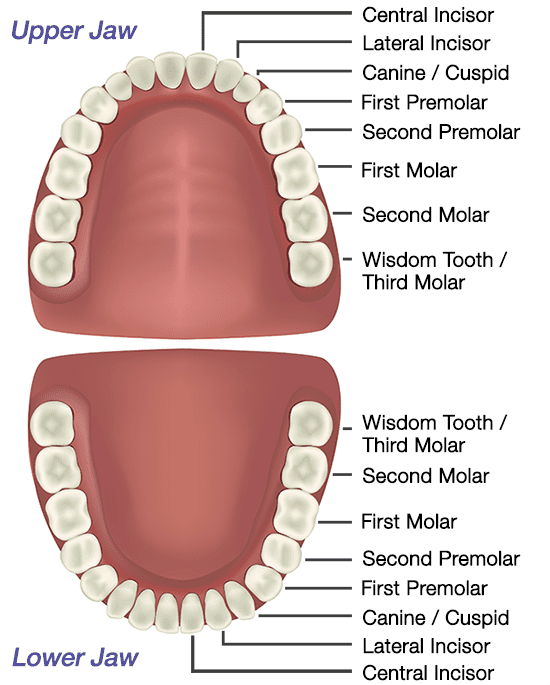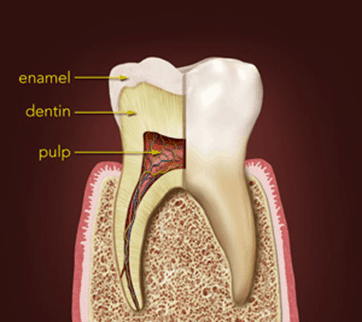In spite of their little size, your teeth are in reality complex and continually changing as you age. So as to appropriately think about your teeth, it is basic to comprehend the anatomy of teeth.
While the mouth is a little piece of our general anatomy of teeth, it’s loaded up with numerous parts and players, all of which cooperate to enable you to eat, drink, talk and have a brilliant grin. The key players are incisors, canines, premolars, molars, crowns, gum line, root, veneer, dentin and mash.
What Are the Different Types of Teeth
Here’s a speedy diagram of the various kinds of teeth in a normal mouth:

Incisors – the sharp, etch molded front teeth (four upper, four lower) utilized for cutting food.
Canines – at times called cuspids, these teeth are formed like focuses (cusps) and are utilized for tearing and getting a handle on food.
Premolars – these teeth have two pointed cusps on their gnawing surface and are once in a while alluded to as bicuspids. The premolars are for pounding and tearing food.
Molars – utilized for pounding and biting food, these teeth have a few cusps on the gnawing surface to help in this procedure.
What Are The Different Parts Of A Tooth?
Every tooth has a few unmistakable parts; here is a review of each part:
Polish – this is the external and hardest piece of the tooth that has the most mineralized tissue in the body. It very well may be harmed by rot if teeth are not thought about appropriately.
Dentin – this is the layer of the tooth under the enamel. On the off chance that rot endures the lacquer, it next assaults the dentin — where a large number of minuscule cylinders lead legitimately to the dental mash.
Pulp – this is the delicate tissue found in the focal point all things considered, where the nerve tissue and veins are found. On the off chance that tooth rot arrives at the mash, you as a rule feel torment and may require a root trench technique.

Teeth Contain Layers
All teeth have three layers: veneer, dentin, and mash. The polish is the peripheral layer and is principally made of calcium phosphate minerals. Polish is the hardest substance in the human body, yet it doesn’t develop back once it’s lost. Microorganisms can shape a biofilm called plaque on the outside of teeth and the carboxylic acids delivered by these microbes can wear out your polish, causing dental caries (cavities) and affectability. To keep plaque from working up on the lacquer and devastating it, make sure to brush at any rate two times every day with a delicate bristled toothbrush, floss like clockwork to disturb bacterial provinces, use fluoridated mouthwash, and get a dental cleaning at regular intervals or as suggested by your dental specialist.
Dentin is the center layer of the tooth and contains the two minerals and tubules prompting the mash. Dentin is multiple times gentler than polish. Tooth affectability can be brought about by whatever uncovered dentin, for example, brushing excessively hard, eating acidic nourishments that break up polish, splitting your tooth, or utilizing a lot finished – the- – counter brightening items that wear out veneer. In the event that you experience the ill effects of tooth affectability, call your dental specialist.
Mash is the deepest and coldest layer of teeth. It contains living tissue (blood and nerves) that plummets beneath the gum line alongside dentin. On the off chance that a cavity arrives at the mash, root canal treatment might be important to expel the disease and spare the tooth. On the off chance that the tooth can’t be spared, it might be extricated.
Portions of the Tooth
The gnawing surface of the tooth is known as the crown and is significant for biting and discourse. The crown is covered with veneer to shield the dentin and mash from microscopic organisms and improvements that may cause affectability. The foundation of the tooth dives beneath the gum line, tying down the tooth in the gums. The outside of the root is covered in a hard layer of tissue called cementum. On one side of the root, the cementum is joined to the periodontal (gum) tendon. On the opposite side, the cementum is associated with the dentin. The neck of the tooth is the place the crown and root meet at the gum line.
Anatomy of teeth
There are additionally four classes of teeth and all have various capacities and structures. Incisors are your front center four teeth on the top and base of your mouth and are utilized for slicing food because of their etch shape. The anatomy of canine teeth is next as you move away from the midline and their sharp shape is helpful for attacking food. Anatomy of canine teeth there are two premolars on each side of the mouth on both the top and base. Premolars, otherwise called bicuspids, have two cusps that are utilized for tearing and pounding food. At last, your molars are farthest back in your mouth and their numerous cusps are valuable for granulating food.
Expert opinion
- Dr. Manan Dhulia Dental Director of Sabka dentist says “Teeth enamel is the hardest substance in the human body, and healthy enamel is resistant to cavity-causing bacteria.”










